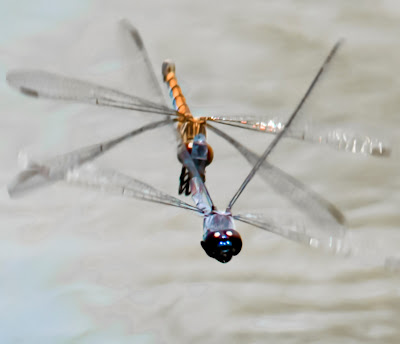 |
| A couple of Seaside Dragonlets whizzed over a wetlands pond. |
When I saw the two dragonflies together, I assumed they must be lovers. But if so, it was a strange embrace, as they seemed to be attached tail to head.
And they were different colors – the one in front was blue and the back one was orange.
Were they two different types of dragonflies having a battle over territory?
I was sitting by the black mangrove pond near my house with my telephoto lens, waiting to see what birds might appear, so I was in no hurry and was able to watch – and document – the interesting dance of the dragonflies.
Later when I looked up the different types of dragonflies found in the Virgin Islands, I learned that these were a couple of Seaside Dragonlets, about an inch and a half long. The male is the blue one, and the female is orange. But what were they up to?
Another time I had seen what I thought were dragonflies mating, and they were locked in a dramatic ‘wheel’ embrace. I was thrilled to get a photo of their amazing posture!
 |
| A pair of Argia concinna damselflies (male above) hooking up on a grass stem |
Those actually turned out to be damselflies, but they are closely related to dragonflies, and I read that the wheel position is the norm for mating dragonflies as well.
The male’s sperm is released from the center of his abdomen, so the female (below in the photo) has to reach her tail end up and around above her to connect with the male’s abdomen and complete the ‘mating wheel’, while he keeps a tight grip on the back of her neck.
The damselflies were perched on a sturdy piece of grass. The Seaside Dragonlets, however, are apparently more acrobatic and can do the wheel position thing even while they are flying around.
When the male dragonfly spots an attractive female, he will fly up behind her and grab her with his legs. Then he scooches up and uses two special grippers at the end of his tail to clasp her tightly by the neck, in what is called ‘tandem linkage’. After that, they figure out how to maneuver themselves into the wheel position.
 |
| These Seaside Dragonlets demonstrate ‘tandem linkage’, with the blue male in front gripping the female behind him with special clasps on his tail |
The dragonlet couple I saw must have already finished mating. But they were still attached as they flew by.
And it wasn’t just a loving embrace. I read that the male will keep his tight hold on her neck until she deposits her fertilized eggs in the pond. That way he can make sure that she doesn’t go around mating with other competitors in the meantime, as she might otherwise be tempted to do.
 |
| A female dragonlet dips her tail down to deposit eggs in a shallow pond. |
While the dragonlets were hovering over a shallow edge of the pond, the female lowered her tail down into the water, and appeared to be releasing her eggs. They flew back and forth, and repeated this process several times in the same spot before finally taking off and disappearing.
 |
| The male dragonlet (blue) keeps a tight grip on the female’s neck as she deposits her eggs. |
When the eggs hatch, the tiny larvae, called nymphs, will swim around hunting for even smaller pond creatures to eat. As they grow, the nymphs will molt many times before finally crawling out of the pond, developing wings, and becoming adult dragonflies.
Most dragonflies breed in fresh water, but the Seaside Dragonlets are uniquely able to tolerate the salty water in the Virgin Islands’ brackish mangrove wetlands, as well as more northern salt marshes. The nymphs are able to regulate their internal osmotic pressure to avoid damage from high salt concentrations.
I hadn’t paid too much attention to the dragonflies by the pond before, so I was glad to be able to get some photos of these dragonlets and learn a bit more about them.